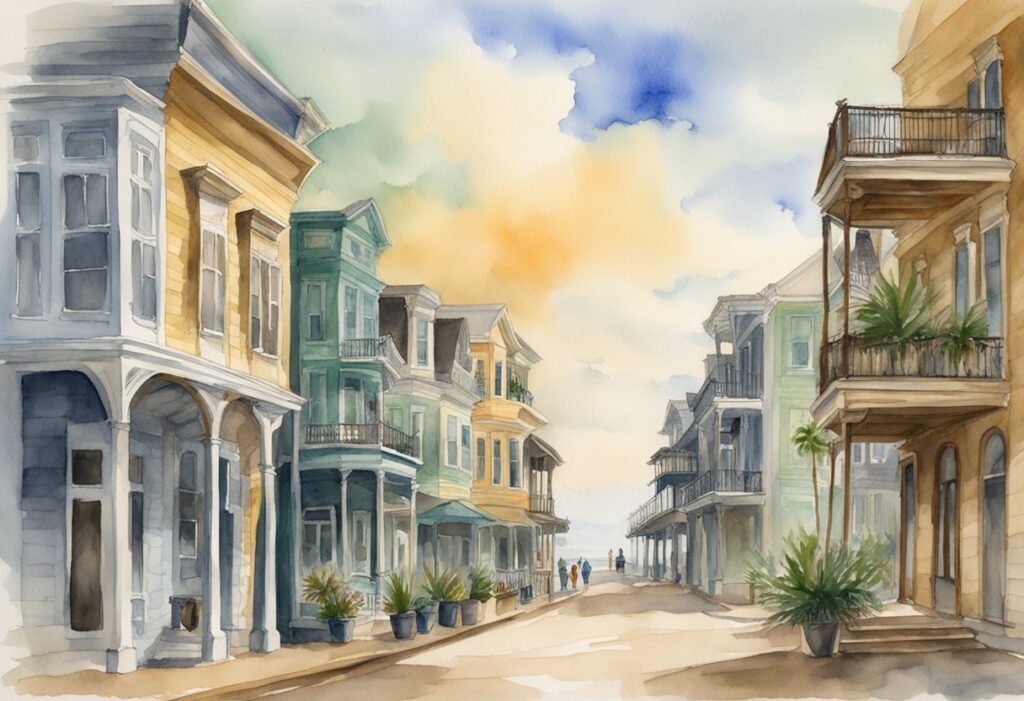If you’re looking for a unique vacation destination in the United States, Galveston, Texas might be just what you’re looking for.
This coastal city boasts a rich history and plenty of interesting facts that are sure to intrigue visitors of all ages. From its early beginnings as a pirate haven to its devastating hurricane in 1900, Galveston has a story to tell.

Galveston’s history dates back to the early 1800s when it was a bustling port city for the Republic of Texas. Over the years, it became a popular tourist destination known for its beautiful beaches, lively entertainment, and delicious seafood. Today, Galveston is a vibrant city with a deep appreciation for its past, making it a fascinating place to explore. Whether you’re interested in learning about the city’s role in the Civil War or discovering the legends of its most famous pirate, Jean Lafitte, Galveston has something to offer everyone.
Historical Significance of Galveston
Galveston, Texas, has a rich and fascinating history that spans over several centuries. From the Civil War to the Great Storm of 1900, Galveston has seen it all. In this section, we will explore some of the most significant events in the city’s history.
The Birthplace of Juneteenth
Galveston played a pivotal role in the history of African Americans in the United States. On June 19, 1865, Union General Gordon Granger arrived in Galveston and announced General Order No. 3, which declared that all slaves in Texas were free. This event, which became known as Juneteenth, is now celebrated as a holiday in many states.
Galveston During the Civil War
During the Civil War, Galveston was an important port for the Confederacy. In 1862, Union forces captured the city, but it was retaken by Confederate troops a few months later. The city remained under Confederate control until the end of the war.
The Great Storm of 1900
One of the most significant events in Galveston’s history was the Great Storm of 1900. This hurricane was one of the deadliest natural disasters in United States history, with an estimated death toll of 6,000 to 12,000 people. The storm devastated the city, destroying thousands of homes and businesses. In the aftermath of the storm, Galveston was rebuilt on higher ground, and a seawall was constructed to protect the city from future storms.
Galveston’s history is full of fascinating stories and events. From the Emancipation Proclamation to the Great Storm of 1900, the city has played a significant role in American history. Whether you are a history buff or just curious about the past, Galveston is a city that is sure to captivate and inspire you.
Cultural and Economic Growth
Galveston’s cultural and economic growth has been shaped by a variety of factors, including its location on the Gulf of Mexico, its role in the cotton trade, and its history of piracy and privateering. In this section, we explore some of the key moments in Galveston’s history that have contributed to its development as a cultural and economic hub.
The Strand Historic District
One of the most iconic areas in Galveston is The Strand Historic District. This area was once the center of the city’s commercial and cultural life, and it is now a popular destination for visitors and locals alike. The district is home to a variety of shops, restaurants, and historic buildings, including the Galveston Historical Foundation, which works to preserve the city’s rich history.
Galveston’s Economic Boom
Galveston experienced a major economic boom in the late 19th century, thanks in large part to its role in the cotton trade. The city was one of the largest cotton ports in the world, and its prosperity attracted a diverse array of people and businesses. During this time, Galveston also became a major center for shipping and trade, with the Port of Galveston playing a key role in the city’s continued growth.
The Era of Piracy and Privateering
Galveston has a fascinating history of piracy and privateering, which played a significant role in the city’s early development. One of the most famous pirates to operate in the area was Jean Lafitte, who used Galveston as a base for his operations in the early 19th century. Privateering was also a common practice during this time, with many Galvestonians participating in the lucrative trade of capturing enemy ships and selling their goods.
Overall, Galveston’s cultural and economic growth has been shaped by a variety of factors, from its role in the cotton trade to its history of piracy and privateering. Today, the city continues to thrive as a center for commerce, tourism, and culture, with a rich history that is still visible in its many historic buildings and landmarks.
Modern Attractions and Education
Galveston has a lot to offer in terms of modern attractions and education. From museums and galleries to higher education institutions, there is something for everyone.
Galveston’s Museums and Galleries
Galveston Island is home to several museums and galleries that showcase the area’s rich history and culture. The Moody Gardens is one of the most popular attractions on the island, featuring a variety of exhibits and displays that focus on science and nature. The museum has a 3D theater, an aquarium, and a rainforest exhibit.
The Rosenberg Library is another must-visit attraction in Galveston. This library is one of the oldest in Texas and features an extensive collection of books, manuscripts, and artifacts related to the island’s history. The library also has a museum that showcases the island’s history, including its role in the Civil War and the 1900 hurricane.
Art lovers will also enjoy the art galleries on the island. From contemporary art to traditional paintings, there is something for everyone. Some of the popular galleries include the Galveston Arts Center and the Galveston Art League.
Higher Education Institutions
Galveston is also home to several higher education institutions, including the University of Texas Medical Branch and Texas A&M University at Galveston. The University of Texas Medical Branch is a top-ranked medical school that offers undergraduate and graduate programs in medicine, nursing, and health professions. Texas A&M University at Galveston is a branch campus of Texas A&M University and offers undergraduate and graduate programs in marine biology, marine engineering, and other related fields.
In conclusion, Galveston has a lot to offer in terms of modern attractions and education. Whether you are interested in science, history, or the arts, there is something for everyone on the island.
Natural Disasters and Recovery
Galveston, Texas, has a long history of natural disasters, particularly hurricanes. The most devastating hurricane in the city’s history was the Galveston Hurricane of 1900, which killed an estimated 6,000 to 12,000 people. Since then, the city has been hit by several major hurricanes, including Hurricane Ike in 2008.
Hurricane Ike and Restoration Efforts
Hurricane Ike was a Category 2 hurricane that hit Galveston on September 13, 2008. The storm caused significant damage to the city’s infrastructure, including its famous seawall. The seawall, which was built after the 1900 hurricane, is a 10-mile-long wall that protects the city from storm surges.
After Hurricane Ike, the city launched a massive restoration effort to repair the damage caused by the storm. The restoration effort included rebuilding the seawall and repairing the city’s infrastructure. The restoration effort was successful, and Galveston was able to bounce back from the storm.
Today, Galveston is a thriving resort business with a booming tourism industry. The city’s beautiful beaches and historic downtown area make it a popular destination for tourists from around the world. Despite the city’s history of natural disasters, Galveston has proven to be a resilient city that is able to recover from even the most devastating storms.

